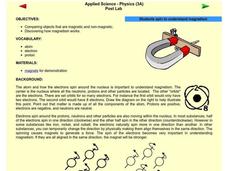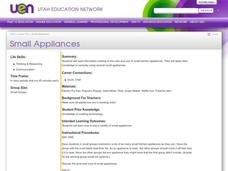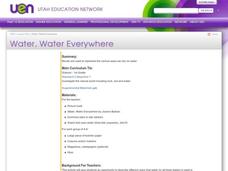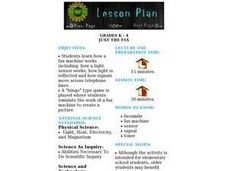Curated OER
Can You See the Music?
Fourth graders examine the makeup of the electromagnetic spectrum and how the various forms of EMRs are similar and different from each other. They, in pairs, solve problems from worksheets imbedded in this lesson plan.
Curated OER
Efficiency
Fourth graders work cooperatively to investigate the efficiency of various household appliances. They share their findings in three to five minute oral presentations.
Curated OER
Community Action
Fifth graders brainstorm a list of decisions that students make daily that affect the welfare of the environment categorizing them as being either helpful or harmful. They then trace local actions to distant consequences to determine how...
Curated OER
Revamped Recipe
Fifth graders engage in a tasty lesson which assist them with proportional measurements. They use a given recipe written for 12 servings, and use a chart to determine the ingredient amounts for 30 servings (or number of students in class).
Curated OER
Hey, I Don't Have Enough Stuff!
Third graders discover through this simulated activity that resources are unequally distributed throughout the world and that regions use resources differently. They, in groups, are assigned to research a different hemisphere.
Curated OER
Magnetism in Action
Third graders experiment with magnetic force and magnetic fields. They examine how magnetic forces can act through a distance.
Curated OER
Trades People
Learners discuss the names of the people who work on various stuctures. They examine the many different roles people in construction can have. They match tools with the correct job and sing songs about workers.
Curated OER
Magnetic Discovery Bottle
Students examine how to conduct simple investigations and use simple equipment to gather data. In this magnet lesson students decide what types of objects are attracted to magnets.
Curated OER
Magnetism
Students study magnetism. In this science lesson, students participate in an activity to discover how electrons in a magnet move. Students identify items around the classroom that are magnetic.
Curated OER
Kitchen Safety
Students examine rules and guidelines for Kitchen Safety by practicing them to prevent and maintain a safe working environment for themselves and others.
Curated OER
Your Amazing Brain
In these reading comprehension worksheets, 8th graders read a passage about the brain. Students then answer 5 reading comprehension questions about the text.
Curated OER
Summertime -- Camping Memory Game
Students discuss the items needed to camp outside. They identify objects in a backpack and tell what the item could be used for. They hide the objects throughout the room and they are to find them.
Curated OER
TE Activity: The Trouble with Topos
Students study the uses of topographical maps including the many forms that they take. They discover that the map features show its intended use such as city maps, wilderness maps, and state maps. They complete a worksheet in which they...
Curated OER
Small Appliances
Students read about the care and use of small kitchen appliances and correctly use several of the appliances.
Curated OER
Water, Water Everywhere
First graders study water-its properties, its 3 states, and the way we rely on it for everyday living. They read Water, Water Everywhere, draw murals of where they have seen water and the ways they use it and eat/drink snacks that are...
Curated OER
How to verify the relationship between the wavelength and frequency of light
Pupils collaborate in heterogeneous groups with each student having a different role. They comprehend the relationship between the frequency and wavelength of light. They record their observations in a table that is included on this...
Curated OER
Magnetic Mapping
Students draw arrows to show the direction the compass needle is pointing when it is placed around different points of a penny and a bar magnet. Students must then answer questions about the activity on a provided worksheet.
Curated OER
Just The Fax
Learners discover how a fax machine works including: how a light sensor works, how light is reflected and how signals move across telephone lines. A "bingo" type game is played where students simulate the work of a fax machine to create...
Curated OER
A Case of Innovation
Students use strategies to comprehend technical writing. They write reports with great detail, supporting material, and clear vocabulary. They incorporate source materials into their speaking and writing and use voice, tone, and style.
Curated OER
Music
Third graders incorporate two formal music lessons into the core curriculum. They study whole notes and rests, syllables of the musical scale and practice singing.
Curated OER
Acceleration
Students develop an understanding of velocity and to distinguish it from speed. To determine the difference between a scalar and a vector quantity. To explore how acceleration is derived from velocity and time.
Curated OER
Sizing Up Sound
Sixth graders are introduced to the concepts of sound waves and frequency. As a class, they listen to the differences between different types of instruments. To end the lesson, they practice identifying low and high pitches and playing...
University of Illinois
University of Illinois Urbana Champaign: Chemistry Learning Center: Electrolysis of Water Using an Electrical Current
From the Chemistry Learning Center at the University of Illinois, this page explains the chemical changes occurring during a water electrolysis lab. Textual information is accompanied by photographs which clearly illustrate the changes.
McGraw Hill
Online Learning Center: Electric Potential and Capacitance
A series of pages which define key terms and explain basic concepts related to electric potential. Includes a set of practice problems with answers and solutions.

























